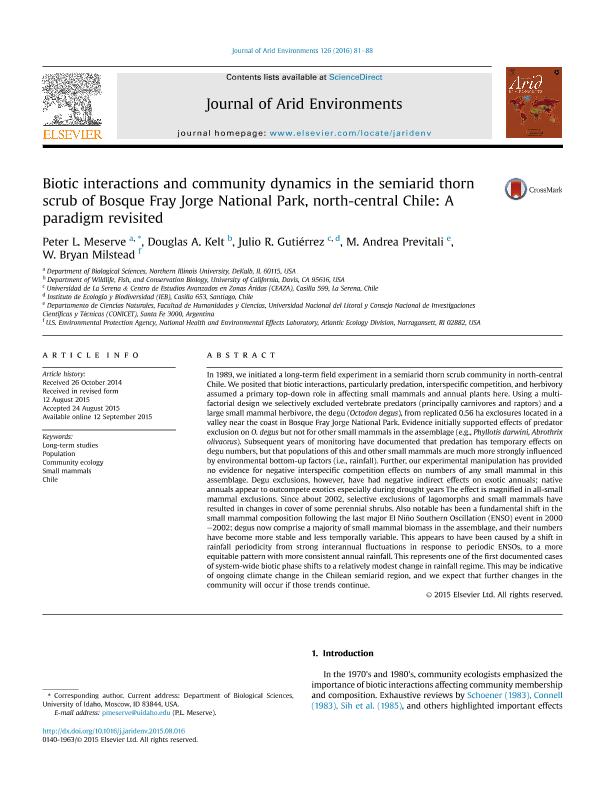Mostrar el registro sencillo del ítem
dc.contributor.author
Meserve, Peter L.
dc.contributor.author
Kelt, Douglas A.
dc.contributor.author
Gutiérrez, Julio R.

dc.contributor.author
Previtali, Maria Andrea

dc.contributor.author
Milstead, W. Bryan
dc.date.available
2018-05-28T20:22:33Z
dc.date.issued
2015-09
dc.identifier.citation
Meserve, Peter L.; Kelt, Douglas A.; Gutiérrez, Julio R.; Previtali, Maria Andrea; Milstead, W. Bryan; Biotic interactions and community dynamics in the semiarid thorn scrub of Bosque Fray Jorge National Park, north-central Chile: A paradigm revisited; Academic Press Ltd - Elsevier Science Ltd; Journal of Arid Environments; 126; 9-2015; 81-88
dc.identifier.issn
0140-1963
dc.identifier.uri
http://hdl.handle.net/11336/46342
dc.description.abstract
In 1989, we initiated a long-term field experiment in a semiarid thorn scrub community in north-central Chile. We posited that biotic interactions, particularly predation, interspecific competition, and herbivory assumed a primary top-down role in affecting small mammals and annual plants here. Using a multi-factorial design we selectively excluded vertebrate predators (principally carnivores and raptors) and a large small mammal herbivore, the degu (Octodon degus), from replicated 0.56 ha exclosures located in a valley near the coast in Bosque Fray Jorge National Park. Evidence initially supported effects of predator exclusion on O. degus but not for other small mammals in the assemblage (e.g., Phyllotis darwini, Abrothrix olivaceus). Subsequent years of monitoring have documented that predation has temporary effects on degu numbers, but that populations of this and other small mammals are much more strongly influenced by environmental bottom-up factors (i.e., rainfall). Further, our experimental manipulation has provided no evidence for negative interspecific competition effects on numbers of any small mammal in this assemblage. Degu exclusions, however, have had negative indirect effects on exotic annuals; native annuals appear to outcompete exotics especially during drought years The effect is magnified in all-small mammal exclusions. Since about 2002, selective exclusions of lagomorphs and small mammals have resulted in changes in cover of some perennial shrubs. Also notable has been a fundamental shift in the small mammal composition following the last major El Niño Southern Oscillation (ENSO) event in 2000?2002; degus now comprise a majority of small mammal biomass in the assemblage, and their numbers have become more stable and less temporally variable. This appears to have been caused by a shift in rainfall periodicity from strong interannual fluctuations in response to periodic ENSOs, to a more equitable pattern with more consistent annual rainfall. This represents one of the first documented cases of system-wide biotic phase shifts to a relatively modest change in rainfall regime. This may be indicative of ongoing climate change in the Chilean semiarid region, and we expect that further changes in the community will occur if those trends continue.
dc.format
application/pdf
dc.language.iso
eng
dc.publisher
Academic Press Ltd - Elsevier Science Ltd

dc.rights
info:eu-repo/semantics/openAccess
dc.rights.uri
https://creativecommons.org/licenses/by-nc-sa/2.5/ar/
dc.subject
Long Term Studies
dc.subject
Populations
dc.subject
Community Ecology
dc.subject
Small Mammals
dc.subject.classification
Otras Ciencias Biológicas

dc.subject.classification
Ciencias Biológicas

dc.subject.classification
CIENCIAS NATURALES Y EXACTAS

dc.title
Biotic interactions and community dynamics in the semiarid thorn scrub of Bosque Fray Jorge National Park, north-central Chile: A paradigm revisited
dc.type
info:eu-repo/semantics/article
dc.type
info:ar-repo/semantics/artículo
dc.type
info:eu-repo/semantics/publishedVersion
dc.date.updated
2018-05-04T21:45:42Z
dc.journal.volume
126
dc.journal.pagination
81-88
dc.journal.pais
Países Bajos

dc.journal.ciudad
Amsterdam
dc.description.fil
Fil: Meserve, Peter L.. University of Illinois; Estados Unidos
dc.description.fil
Fil: Kelt, Douglas A.. University of California; Estados Unidos
dc.description.fil
Fil: Gutiérrez, Julio R.. Universidad de La Serena; Chile
dc.description.fil
Fil: Previtali, Maria Andrea. Universidad Nacional del Litoral. Facultad de Humanidades y Ciencias. Departamento de Ciencias Naturales; Argentina. Consejo Nacional de Investigaciones Científicas y Técnicas. Centro Científico Tecnológico Conicet - Santa Fe; Argentina
dc.description.fil
Fil: Milstead, W. Bryan. U.S. Environmental Protection Agency; Estados Unidos
dc.journal.title
Journal of Arid Environments

dc.relation.alternativeid
info:eu-repo/semantics/altIdentifier/doi/http://dx.doi.org/10.1016/j.jaridenv.2015.08.016
dc.relation.alternativeid
info:eu-repo/semantics/altIdentifier/url/https://www.sciencedirect.com/science/article/pii/S0140196315300409
Archivos asociados
